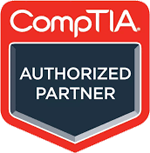CompTIA Security+ SY0-701 Course Overview
The CompTIA Security+ SY0-701 course is a thorough educational program created to give students the information and abilities needed to safeguard devices, networks, and applications. It ensures that participants are knowledgeable about the prevention and mitigation of various threat types by giving them a basic understanding of security concepts. Students will study identity and access management, cryptographic solutions, and cloud and enterprise network architecture security techniques through interesting lessons. Along with covering important subjects like network and endpoint security capabilities, the course places a strong emphasis on resilience, site security, and vulnerability management. In addition to learning how to analyze indicators of malicious activity, participants will gain a deeper understanding of application security, incident response, and monitoring. In addition, the curriculum explores concepts related to Data Protection, Security Governance, Risk Management, and Compliance, making sure students are ready to take on the challenges of cybersecurity in today’s ever-changing environments. After completing the course, students will be prepared to sit for the Security+ certification exam, which will open up a wide range of cybersecurity job options.
Course Prerequisites
In order to guarantee that students can effectively understand the material and derive maximum benefits from the CompTIA Security+ SY0-701 course, Koenig Solutions advises that attendees meet the following minimal requirements:
- Basic knowledge of network terminology and computer systems.
- knowledge of how popular operating systems, like Windows, macOS, or Linux, work.
- Familiarity with the fundamentals of networking, such as IP addressing, the OSI model, and common networking protocols.
- Some hands-on familiarity with intrusion detection systems, firewalls, and antivirus software as they relate to network security.
- Knowledge of important security concepts, including the CIA triad of availability, integrity, and confidentiality
- Ideally two years or more of experience in IT administration with a security-focused background.
- Although not required, having CompTIA Network+ certification or similar knowledge is advised.
Target Audience for CompTIA Security+ SY0-701
IT professionals looking to certify their security knowledge and skills can take the CompTIA Security+ SY0-701 course. The following job roles and people are targeted by the CompTIA Security+ SY0-701 course:
- Experts in IT Security
- Administrators of Networks
- Consultants in Security
- Engineers in Security
- Administrators of Systems
- IT Examiners
- Analysts of Cybersecurity
- Help Desk Technicians who want to become more senior security officers
- Professionals in Information Assurance
- Compliance or Risk Analysts
- Integrators and Installers of Security Systems
- IT professionals looking to move into roles with a security focus
- Students interested in working in IT security
- Government and military employees who need security certifications
- Professionals getting ready for the certification test for CompTIA Security+
WLearning Objectives – What you will Learn in this CompTIA Security+ SY0-701?
Introduction to Course Learning Outcomes and Concepts Covered
In order to safeguard contemporary business environments, the CompTIA Security+ SY0-701 course is intended to give students a solid understanding of cybersecurity principles, threat mitigation, and risk management.
Learning Objectives and Outcomes:
Recognize Basic Security Concepts:
- Understand the fundamentals of availability, integrity, and confidentiality (CIA).
Acknowledge the significance of risk management and security controls.
Determine and Contrast Danger Types:
- Make distinctions between different malware types, assaults, and threat actors.
- Examine the possible effects of threats on the security of your organization.
Describe the following cryptographic solutions:
- Recognize the function and workings of cryptographic algorithms.
- Utilize cryptographic methods to protect data within organizations.
Put Identity and Access Management into Practice:
- Oversee authentication procedures and access control models.
- Put secure account management procedures and identity management solutions into practice.
Architecture for a Secure Enterprise Network:
- Create security policies for network infrastructure and implement them.
- To improve security, use VPNs, firewalls, and network segmentation.
Architecture for a Secure Cloud Network:
- Utilize security principles in cloud computing settings.
- Recognize cloud service models and the security implications associated with them.
Describe the concepts of site security and resilience:
- Create plans for business continuity and organizational resilience.
- Recognize the protective measures for the environment and physical security.
Vulnerability management explained:
- Carry out vulnerability assessments and efficiently handle risks that are found.
- Set remediation priorities according to vulnerability assessments.
Analyze the resources for network security:
- Evaluate the protocols and tools used in network security.
- To counter threats, implement cutting-edge network security solutions.
Examine the security capabilities of endpoints:
- Protect different endpoints from misuse and data loss.
- Put endpoint detection and response systems into practice.
Boost the Capabilities of Application Security:
- Evaluate the security posture of your application and use secure coding techniques.
- Make use of automatic tools and application security frameworks.
Describe the concepts of incident response and monitoring:
- Create and carry out plans for incident response.
- Keep an eye out for anomalies and security breaches in networks and systems.
Examine Malicious Activity Indicators:
- Recognize and evaluate indicators of security breaches.
- To find malicious activity, use indicators of compromise (IoCs) and threat intelligence.
Recap the Concepts of Security Governance:
- Recognize the function of guidelines, norms, and practices in security governance.
- Recognize the significance of ethical and compliance issues.
Describe the procedures for risk management:
- Utilize risk assessment techniques to recognize and reduce hazards.
- Include risk management in operational procedures.
Recap the concepts of data protection and compliance:
- Use best practices for data privacy and security to safeguard sensitive information.
- Recognize how compliance standards and regulations affect data security.

Testimonials
Duke Training Centre Unique Offerings
Online Instructor Led
With the convenience of your home or workplace, you can learn from our knowledgeable trainers online.
Classroom Training
In-person instruction in a physical classroom with maximum interaction at our five-star training facilities.
Schedule Dates
01 November 2024
01 November 2024
01 November 2024
01 November 2024



 Duration
Duration Language
Language Batch Options
Batch Options Upcoming Batch
Upcoming Batch






